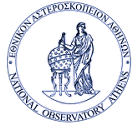|
|
|
Atmospheric Chemistry &
Climate Change Modelling
|
The Atmospheric Chemistry and Climate Change Modelling
(A3CM) research team is one of seven groups at the Institute
of Environmental Research and Sustainable Development (IERSD),
one of the five institutes at the National Observatory of
Athens (NOA), the oldest research centre in Greece.
| Atmospheric Chemistry
Research |
Aims :
-
Quantify the export and chemical evolution
of radiatively and chemically important trace gases and
aerosols from Europe to the eastern Mediterranean
-
Quantify the impact of the European pollution
on the eastern Mediterranean
-
Elucidate mechanisms and pathways associated
with the transport and transformation of these trace chemicals
-
Characterise the air masses entering Greece
and the eastern Mediterranean
-
Comparison of measured chemical fields
from airborne experiments with those predicted by the
model
-
Focus on ozone precursors and
-
Quantify links between future air quality
and climate
-
GEOS-CHEM as chemistry transport model
from Harvard University, in collaboration with Athens
University.
-
MINOS (Mediterranean Intensive Oxidant
Study) campaign for measurements
-
Simulations and runs by switching off
regionally emissions
-
Nesting of the global GEOS-CHEM model
to 1x1 resolution
Output example:
|
|
Ozone concentration from assimilated Geos-Chem model
in the upper
troposphere (8.7 km) for January and July of 2001.
|
| Climate Change and Impact
Studies |
Current activities :
-
Extraction of climate extremes for analysis
-
Time series of extremes under climate
change
-
Spatial paterns of extremes under climate
change
-
Quantitative modelling of impacts of changes
in climate extremes on activiy sectors
-
Expert-judgement based approaches to understanding
impacts of changes in climate extremes on activity sectors
Examples of Extremes used for Impact Sector Analysis :
|
Impact Category
|
Climate Extreme
|
Parent Variable
|
|
(a) Forestry
- Wind throw
- Forest fire
- Ecological damage
|
- Wind storm
- Heat stress, drought
- Flood, drought, heat stress
|
- Storm tracking
- Temperature, rainfall
|
| (b) Mediterranean Agriculture |
Heat stress, Drought |
Temperature, Rainfall |
| (c) Energy Use |
Summer heat waves |
Temperature |
| (d) Tourism |
Heat stress, deficit or excess
of snow |
Temperature, Precipitation |
|
(e) Insurance/Civil Protection
- Property damage
- Loss of life
|
|
- Storm tracking
- Rainfall, snow
|
|
|
Number of weeks (per year) with fire risk (FWI
> 15): variation between 1960-1990 and 2030-2060
averages, according to the HadCM3 simulations.
|
Future directions:
-
Use output from a wide selection of climate
models (global and regional) to an objective probalistic
estimate of uncertainty in future climate at the seasonal,
decadal and longer timescales
-
link the outputs to a range of applications,
including agriculture, health, food security, energy,
water resources, insurance and risk management
-
produce estimates of future air quality
using climate model output to drive our chemistry transport
model GEOS-CHEM
-
EU projects such as MICE (Modelling the
Impacts of Climate Extremes), ENSEMBLES (ensemble-based
predictions of climate changes and their impacts), DeSurvey
(a surveillance system for assessing and monitoring of
desertification)
|
Dr. C. Giannakopoulos
|
+30 210 810 9138
|
cgiannak@meteo.noa.gr
|
|
Dr. E. Kostopoulou
|
+30 210 810 9151
|
ekosto@meteo.noa.gr
|
|
Dr. P. Le Sager
|
+30 210 810 9151
|
plesager@meteo.noa.gr
|
|
Dr. B. Psiloglou
|
+30 210 810 9133
|
bill@meteo.noa.gr
|
|
Fax
|
+30 210 8103236
|
|
|
|

